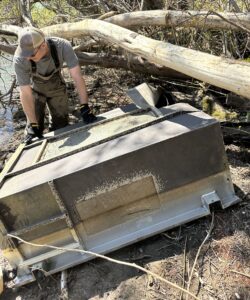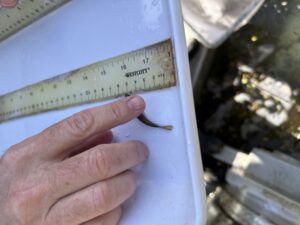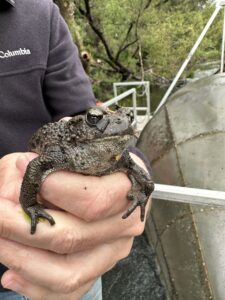By Gabe Seidman, Napa RCD’s GrizzlyCorps Fellow
 As a GrizzlyCorps Fellow at Napa RCD this year, I’ve had the opportunity to work on a wide variety of projects. Over the last few months, one of these projects was assisting with monitoring Napa RCD’s Rotary Screw Trap (RST). If you’re not already familiar, an RST is a large metal structure placed in the middle of a river that operates like a big, funnel-shaped rotating door- catching fish (and other critters) and releasing them into a metal box. The trap is powered by the current of the river, so the rate at which it spins is determined by the speed of the water around it. The RST’s location was chosen very carefully, aiming for the lowest non-tidal reach of the river possible.
As a GrizzlyCorps Fellow at Napa RCD this year, I’ve had the opportunity to work on a wide variety of projects. Over the last few months, one of these projects was assisting with monitoring Napa RCD’s Rotary Screw Trap (RST). If you’re not already familiar, an RST is a large metal structure placed in the middle of a river that operates like a big, funnel-shaped rotating door- catching fish (and other critters) and releasing them into a metal box. The trap is powered by the current of the river, so the rate at which it spins is determined by the speed of the water around it. The RST’s location was chosen very carefully, aiming for the lowest non-tidal reach of the river possible.
 Every morning while the trap is operating, Napa RCD staff go out and count the fish that are caught in the box. Everything that comes into the box is recorded and released, but monitoring is particularly focused on two native salmonid species: steelhead trout (Oncorhynchus mykiss) and Chinook salmon (Oncorhynchus tshawytscha). Salmonid species like these are commonly called indicator species, because their health reflects the overall ecological health of the watershed.
Every morning while the trap is operating, Napa RCD staff go out and count the fish that are caught in the box. Everything that comes into the box is recorded and released, but monitoring is particularly focused on two native salmonid species: steelhead trout (Oncorhynchus mykiss) and Chinook salmon (Oncorhynchus tshawytscha). Salmonid species like these are commonly called indicator species, because their health reflects the overall ecological health of the watershed.
When Chinook salmon are caught, the fish’s length and weight are documented, and a genetic sample is collected before it is released back upstream. When a steelhead trout is caught, it gets the same treatment as a Chinook, along with a tracking tag (a PIT tag), which are used to identify and track individuals so that they can be re-detected in subsequent years when they return to the Napa River.

This year was a strange one for the RST. Due to heavy rainfalls during the first half of the season, the trap couldn’t be operated and had some damage that needed to be repaired. As a result, the trap was only operational for 29 days this year, compared to an average of 51 days in a given season. Due to the late start, it is likely that the trap missed most of the steelhead outmigration; during the 29 days of operation, only 5 steelhead smolts were caught, compared to an average of 84 per season. Chinook numbers were also relatively low – 353 Chinook salmon were caught during the 29 days of operation this year, compared to an average of 983. Aside from the fact that the operating season was shorter than usual this year, the number of steelhead outmigrants was also likely low due to the last several years of drought, and the Chinook numbers were likely lower due to the impacts of this winter’s high flows.

 Despite the strangeness of the monitoring season, I found assisting with the RST to be a very rewarding experience. Most of my work with Napa RCD this year has been centered around forestry, so it was interesting to zoom out a little bit and look at other work Napa RCD is doing to measure and improve watershed health. Aside from seeing lots of Chinook salmon and a few steelhead, I saw all kinds of other interesting creatures (native and non-native) including crawfish, toads, lampreys, sunfish, Sacramento suckers – the list goes on. The Napa River is a beautiful place to spend an hour or two every morning, and I feel lucky to have been a part of this project. There is so much life and activity just below the surface of the water, and it’s so exciting to see even a small snapshot of it!
Despite the strangeness of the monitoring season, I found assisting with the RST to be a very rewarding experience. Most of my work with Napa RCD this year has been centered around forestry, so it was interesting to zoom out a little bit and look at other work Napa RCD is doing to measure and improve watershed health. Aside from seeing lots of Chinook salmon and a few steelhead, I saw all kinds of other interesting creatures (native and non-native) including crawfish, toads, lampreys, sunfish, Sacramento suckers – the list goes on. The Napa River is a beautiful place to spend an hour or two every morning, and I feel lucky to have been a part of this project. There is so much life and activity just below the surface of the water, and it’s so exciting to see even a small snapshot of it!
